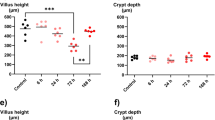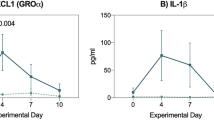Summary
The tolerated dose of melphalan is limited by bone marrow suppression; when this complication is ameliorated by bone marrow transplantation, the dose-limiting toxicity becomes gastrointestinal mucositis. No intervention to date has been successful in modulating this lifethreatening complication of melphalan. We conducted studies to develop a murine model of melphalan-induced gastrointestinal toxicity to facilitate the preclinical identification of effective strategies for reducing this toxicity. Melphalan given at the 90% lethal dosage produced severe gastrointestinal mucositis and mortality (13 of 23 treated mice). Syngeneic bone marrow transplantation, effective in preventing the myeloablation produced by total-body irradiation, was ineffective in preventing melphalan-induced mortality (16 of 23 treated mice), indicating that gastrointestinal mucositis was the dose-limiting toxicity. On the basis of the results of previous studies, which revealed that depletion of glutathione enhances the antineoplastic activity of melphalan and that glutathione is required for murine intestinal function, we attempted to modulate melphalan-induced gastrointestinal toxicity by the administration of glutathione (8–10 mmol/kg given in 1 ml sterile water by gavage at 12-h intervals for 4–8 doses). Glutathione therapy failed to produce a significant increase in mucosal glutathione content in animals treated with melphalan plus glutathione gavage as compared with those receiving melphalan alone (P>0.05), and histologic mucosal injury secondary to melphalan was not reduced. The administration of glutathione in the presence or absence of concomitant bone marrow transplantation did not decrease melphalan-induced mortality (melphalan alone, 16/26 deaths; melphalan plus glutathione, 14/25 deaths; melphalan plus glutathione plus bone marrow transplantation, 20/26 deaths). Studies using a reduced melphalan dose (50% lethal dosage) produced similar results, with no survival benefit being seen following glutathione administration. Our studies suggest that melphalan-induced mucositis can be studied in a mouse model in which this complication is doselimiting. Although glutathione administration at the dose and schedules initially studied is not effective in reducing this damage, other therapeutic strategies such as the use of alternative glutathione regimens or other thiols can be effectively studied in this system.
Similar content being viewed by others
References
Allan SG, Smyth JF, Hay FG, Leonard RCF, Wolf CR (1986) Protective effect of sodium-2-mercaptoethanesulfonate on the gastrointestinal toxicity and lethality ofcis-diamminedichloro platinum. Cancer Res 46: 3569
Beck JT, Matthes S, Steenbergen C, Wormley J, Peters WP, Jones RB (1990) Mesna prevents acute lethality and tissue injury from high dose cyclophosphamide in rats. Proc Am Assoc Cancer Res 31: 332
Bullard DE, Schold SC Jr, Bigner SH, Bigner DD (1981) Growth and chemotherapeutic response in athymic mice of tumors arising from human glioma-derived cell lines. J Neuropathol Exp Neurol 40: 410
Dorr RT, Fritz WL (eds) (1980) Cancer chemotherapy handbook. Elsevier, New York, p 507
Dulik DM, Fenselau C, Hilton J (1986) Characterization of melphalan-glutathione adducts whose formation is catalyzed by glutathione-S-transferase. Biochem Pharmacol 35: 3405
Friedman HS, Colvin OM, Aisaka K, Popp J, Bossen EH, Ramer KA, Powell JB, Hilton J, Gross SS, Levi R, Bigner DD, Griffith OW (1990) Glutathione protects cardiac and skeletal muscle from cyclophosphamide-induced toxicity. Cancer Res 50: 2455
Hersh MB, Ludden TM, Kuhn JG, Knight WA (1983) Pharmacokinetics of high dose melphalan. Invest New Drugs 1: 331
Lazarus HM, Hertzig RH, Graham-Pole J, Wolff SN, Phillips GL, Strandjord S, Hurd D, Forman W, Gordon EM, Coccia B, Gross S, Herzig GP (1983) Intensive melphalan chemotherapy and cryopreserved autologous bone marrow transplantation for the treatment of refractory cancer. J Clin Oncol 1: 359
Lee FYF (1991) Glutathione diminishes the anti-tumor activity of 4-HC by stabilizing its spontaneous breakdown to alkylating metabolites. Br J Cancer 63: 45
Levine ES, Friedman HS, Griffith OW, Colvin OM, Lieberman M (1991) Glutathione modulation affects 4-hydroperoxycyclophosphamide cardiotoxicity. FASEB J 5: 554A
Martensson J, Meister A (1990) Glutathione is required for intestinal function. Proc Natl Acad Sci USA 87: 1715
Ozols RF, Louie KG, Plowman J, et al. (1987) Enhanced melphalan cytotoxicity in human ovarian cancer in vitro and in tumor-bearing nude mice by buthionine sulfoximine depletion of glutathione. Biochem Pharmacol 36: 147
Schmitt LH, Fradkin R, Sullivan R, Flowers A (1965) Comparative pharmacology of alkylating agents. Cancer Chemother Rep [Suppl 2, Parts I, II, III).
Skapek SK, Colvin OM, Griffith OW, Elion GB, Bigner DD, Friedman HS (1988) Enhanced melphalan cytotoxicity following buthionine sulfoximine-mediated glutathione depletion in a human medulloblastoma xenograft in athymic mice. Cancer Res 48: 2764
Suzukake K, Petro BJ, Vistica DT (1982) Reduction in glutathione content ofl-PAM-resistant L1210 cells confers drug sensitivity. Biochem Pharmacol 31: 121–124
Teicher BA, Crawford JM, Holden SA, Lin Y, Cathcart KNS, Luchette CA, Flatow J (1988) Glutathione monoethyl ester can selectively protect liver from high dose BCNU or cyclophosphamide. Cancer 62: 1275
Author information
Authors and Affiliations
Additional information
This study was supported in part by NIH grants DK26912, NS20023, CA56115, CA11898, CA44640, CA42745, and CA40355, by ACS research grant DHP-67D and by Bristol Myers grant 100-R18
Rights and permissions
About this article
Cite this article
Castellino, S., Elion, G.B., Griffith, O.W. et al. Development of a model of melphalan-induced gastrointestinal toxicity in mice. Cancer Chemother. Pharmacol. 31, 376–380 (1993). https://doi.org/10.1007/BF00686151
Received:
Accepted:
Issue Date:
DOI: https://doi.org/10.1007/BF00686151




